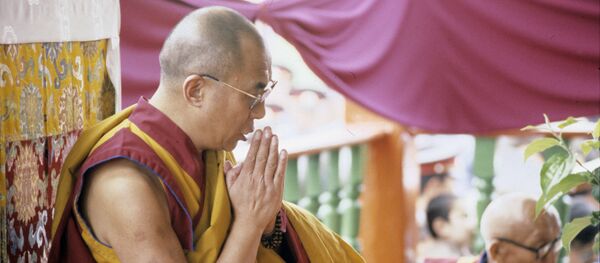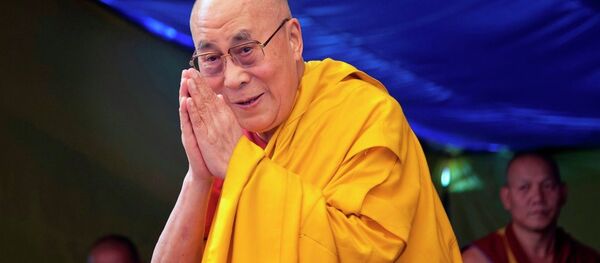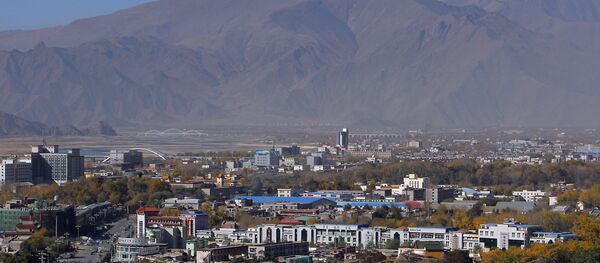His girlfriend seems to belong to the majority. After the recent release of Path of the Soul, which tells the story of 11 Tibetans walking 2,500 kilometers and kowtowing the entire way, millions of moviegoers have praised the film online. Many have said they have drawn strength from its depiction of faith, contrasting it with their modern, materialist lifestyles.
But Lu, even after watching it for a second time, felt the film was nothing special and was puzzled as to why his fellow audience members were weeping.
Along with praise from people like Lu's girlfriend, there has also been a backlash from those who say such pilgrimages cannot help Tibet develop.
"Praying to god does not bring you wealth… I just wonder why don't they use the passion they demonstrate in the pilgrimage on developing their economy and relieving poverty," a netizen named Yiwantudoufen exclaimed on Sina Weibo.
Path of the Soul, which movie insiders thought would only appeal to a niche audience, has aroused a fierce and obviously divided discussion about Tibet, Tibetan Buddhism, and faith — boosting its box office take along the way.
Romantic Notions
Falling to one's knees, straightening up, walking, and then again throwing oneself down, standing up again and then walking on. The Tibetan main characters repeat this process over and over again in Path of the Soul.
"I have been touched by their lives and therefore wanted to make this movie. I'm not trying to enlighten the audience. I'm only trying to share," Zhang Yang, director of the movie, told the Global Times.
Despite the director's stated intentions, it seems many people think the film has somehow enlightened them.
In the film, the group — which includes a senior citizen, a child and a pregnant woman — sets off from a remote village in the Tibet Autonomous Region to kowtow all the way to regional capital Lhasa and then further on to Kang Rinpoche, one of the major holy mountains in Tibetan Buddhism.
The pilgrims — who each have their own reasons for going on the journey — face birth, death, storms and dangerous accidents before arriving at the base of the mountain.
They undergo these hardships, and the hardship of repeatedly beating their foreheads on the ground, because as the child's mother tells her, "Kowtowing is good. Kowtowing brings you wisdom."
For people living a nine-to-five urban lifestyle in relative comfort, the idea of kowtowing through storms and snow all along National Highway 318 is unimaginable.
"Such a topic is very appealing to young people. Tibet has long attracted outsiders. No doubt many see the film as chance to satisfy their curiosity," said Lu, who was driven by this curiosity to quit a well-paid job in Shanghai to live in Tibet for several months two years ago.
The day-to-day lives of Tibetans are barely depicted in the movie, rather it is the pilgrim's extraordinary faith that has attracted audiences.
"I was touched by the simple Tibetans' piety. In comparison, we are just too impulsive, too utilitarian and with much less kindness. It is worth pondering what kind of life we should choose," wrote HaipierTime on Sina Weibo.
"What the movie demonstrates is so different from our life, and provides a mirror for us to compare and reflect. Their spiritual force is impressive," noted Yin Hong, a professor at Tsinghua University.
This infatuation with a romanticized image of Tibetans and their religion being touted as an antidote to the evils of modern life has emerged as a social phenomenon in China in recent years.
A previous Global Times report quoted young Chinese urbanites who blamed food scandals and the pollution problem on their compatriots' lack of faith.
Famous Beijing-born singer Faye Wong posted pictures on her 44th birthday a few years ago which showed her forehead had turned red after performing the kowtow ritual in Tibet. Wong's turn toward Tibetan Buddhism reportedly came as her relationship with her husband broke down.
The number of people from China's more-developed eastern regions traveling to Tibet has been climbing year on year. Besides fulfilling the curiosity of outsiders, it has long been a place where people from urban areas could find comfort to the soul and "find themselves."
Faith Under Attack
On the other hand, some have actually questioned the social role of the Tibetan Buddhist faith itself after the movie was released.
"The real Tibet is, when their relatives get sick, they go on a pilgrimage; when there is a drought, they go on a pilgrimage; when they lose their job, they go on a pilgrimage… such behaviors are clearly foolish, why are people speculating on this topic?" a netizen named Kaleo Lin commented on douban.com.
A netizen named Ziyi recounted the history of Tibet's political history before Beijing introduced the socialist system to the region in 1959 on zhihu.com.
"It is funny that just over 50 years have passed and now so many people regard Tibetans kowtowing as pursuing soul and faith," Ziyi wrote. "But it is not their faith or their masters that transformed them from serfs to citizens."
This comment typifies the mainstream Chinese narrative on Tibet, which has emphasized the government's modernization efforts.
Domestic media and school textbooks have always focused on the liberation of the region. They say that most of the slaves had few possessions, lived in poor conditions and were often whipped or chained by their masters.
Longya, a netizen who said he was a soldier who served in Tibet for 13 years, wrote that even though he defends the Tibetans' right to kowtow, he only saw ignorance and desperation in the movie, instead of hope or wisdom.
"The truck they use, the concrete bridge in their village and the National Highway 318 where they kowtow, are obviously not created by Kang Rinpoche or any Living Buddha. I feel sorry for them," wrote Longya, adding that every kilometer of the highway cost the life of a soldier.
"Please look at the highway, it is a miracle created by a group of young people who had faith in saving the country," Longya wrote in front of several pictures featuring the road, stressing that a lot of Chinese people beyond Tibet, though they are atheists, have their own faith in life.
Multiplying Misunderstandings
These attitudes toward the movie — effusive praise or criticism — seem to have been met with criticism in turn by some Tibetans.
"You can enjoy air-conditioning and WiFi and praise these poor people for their faith, but have you bothered to care that their children may also live in poverty in the future and they may donate half of their income to the temple so that the Lama would touch his head," Hali, who claimed to be a Tibetan, wrote on zhihu.com in response to a netizen who defended Tibetans' religious customs in their entirety.
"Faith is not religion. It is good belief in everyone's heart, like kindness, like bravery," Hali wrote.
"Many people have romantic and idealized feelings about this area and its religion amid their fast-paced urban lives, which have been reinforced by the movie," said Lu. "On the other hand, many are questioning and attacking the faith. Both may be because of a lack of understanding."
His own romantic feelings about Tibet withered after living there and learning about its negative side. "There are simple and honest people with the faith, but there also are teenage beggars. The locals wait and ask for money after you take a photo of a Tibetan Mastiff, and so on," said Lu.
But Lhakpa Dolma, a Tibetan tour guide, said it doesn't matter how outsiders look at her people and their customs.
"Many think we live impoverished lives to torture ourselves. We don't think so. We live in the place closest to the Buddha and with Buddha in our hearts we are happy whatever," she said. "We kowtow for our next life, not to show to others."
"You may not have faith, but you should learn to respect faith," she often tells tourists.
"Whether people praise it or attack it, the meaning of the movie is it provides a good opportunity for people to think about faith," said Yin, professor at Tsinghua University.
So the spat continues, with many sobbing in the theater and others walking out halfway.
This article was originally published in the Global Times.






